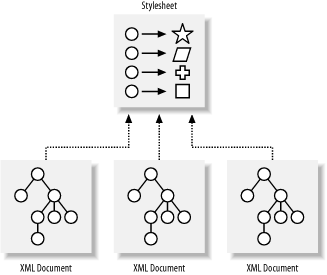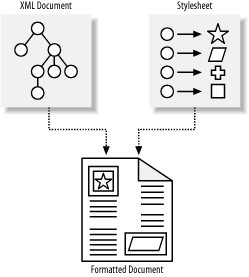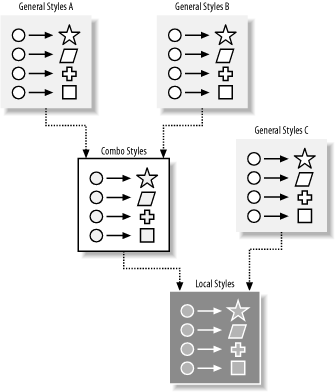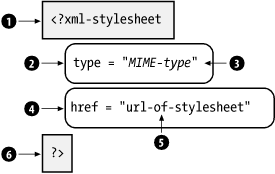5.1 Stylesheets
| XML and stylesheets go together like naked people and clothes. Let's take a moment to familiarize ourselves with the general concepts behind stylesheets. First, why do you want them? Second, how do they work? Finally, are there limitations, and what can we do about them? 5.1.1 Why We Need ThemI can rant about why it's important to keep information pure and separate presentation into stylesheets, but this would ignore a critical question: if it's easier to write in presentational markup ”and I admit that it is ”why would you want to bother with stylesheets? After all, the Web itself testifies to the fact that presentational markup is working quite well for what it was designed to do. For that matter, what's wrong with plain text? If you are already familiar with the sermon, then skip this section, because I'm going to preach the religion of stylesheets now. XML was inspired, to a large extent, by the limitations of HTML. Tim Berners-Lee, the inventor of HTML, always had stylesheets in mind, but for some reason, they had been forgotten in the huge initial surge of webification. Although HTML had only limited presentational capabilities built in, it was enough to satisfy the hordes of new web authors. Easy to implement and even easier to learn, HTML was soon stretched far beyond its original intentions as a simple report-formatting language, forced to encode everything from product catalogs to corporate portals. But the very thing that led to its rapid uptake, presentational markup, is also holding HTML back. Here are some problems associated with presentational markup and some solutions provided by stylesheets:
Figure 5-1. One stylesheet used by many documents
Figure 5-2. Mixing and matching stylesheets for different purposes To summarize, the three principle ways in which stylesheets help you are:
The key to all this is what we in XML intellectual circles call late binding . Keep the document as far away from its final product as possible, and you maximize its flexibility. The stylesheet extends the information into a particular realm, be it online viewing or print or spoken text. 5.1.2 How They WorkThink of applying a stylesheet to a document as preparing a meal from a cookbook. Your XML document is a bunch of raw, unprocessed ingredients ; the stylesheet is a recipe, telling the chef how to handle each ingredient and how to combine them. The software that transmutes XML into another format, based on the stylesheet's instructions, is the chef in our analogy. After the dicing, mixing, and baking, we have something palatable and easily digested. 5.1.2.1 Applying propertiesIn the simplest sense, a stylesheet is like a table that maps style properties to elements in the document (see Figure 5-3). A property is anything that affects the appearance or behavior of the document, such as typeface, color , size, or decoration. Each mapping from element to property set is called a rule . It consists of a part that matches parts of a document, and another that lists the properties to use. Figure 5-3. A stylesheet used to help produce a formatted document The software that uses a stylesheet to generate formatted output is a stylesheet processor . As it reads the XML document, it keeps consulting the stylesheet to find rules to apply to elements. For each element, there may be multiple rules that match, so the processor may apply them all, or it may just try to find one that is the best fit. Matching rules to elements can be a complex process in writing a stylesheet. 5.1.2.2 Client and server-side processingThe result of this processing is either a generated display or another document. The first case is what you would see in a web browser on screen, or a printout from the browser. It's a device-dependent result, created on the client end of the transaction. Client-side processing like this takes the load off of the server making information propagate faster. It also gives the end user more control over the appearance by being able to override some style settings. The other kind of output from a style processor is a new document. XSLT, which we will explore in Chapter 7, is such a stylesheet language. This sort of process is also known as a transformation because it effectively transforms the original document into a different form. Transformations can be performed on either the server or the client end, before or during the transaction. For example, a DocBook document can be transformed into HTML for presentation on a browser. It's a very powerful technique that we will have fun talking about later. 5.1.2.3 Cascading stylesStylesheets can be modularized to mix and match rules. This is the source of the term "cascading" in CSS. The idea is that no stylesheet ought to be monolithic. Instead, you should be able to combine styles from different sources, create subsets , and override rules in different situations. For example, you can use a general-purpose stylesheet combined with one that fine-tunes the style settings for a specific product (see Figure 5-4). Figure 5-4. A cascade of stylesheets One reason for doing this is to make it easier to manage a huge set of style rules. The fix-once-see-everywhere principle is enhanced when changes to one set of rules are inherited by many stylesheets. Cascading rules also make it possible to change the result at any point in the transaction. All browsers in fact have a default client-side stylesheet that specifies how to render HTML in the absence of any specifications from the server. Some browsers, such as Mozilla allow you to edit this local stylesheet, or user stylesheet , so you can customize the appearance to suit your tastes. For example, if you think most text in pages is hard to read, you can increase the default size of fonts and save yourself some eyestrain. 5.1.2.4 Associating a stylesheet to a documentThere is no hard and fast rule for associating resources to documents in XML. Each markup language may or may not provide support for stylesheets. Some languages, like MoDL, have their own software to display or process the data, so it wouldn't make any sense to use stylesheets. In others, the language doesn't have an explicit method for association, so stylesheets are a good idea, as is the case with DocBook. HTML happens to define an element for linking resources like stylesheets to the document. The link element will bind a web page to a CSS stylesheet like this: <html> <head> <title>The Behavior of Martian Bees</title> <link rel="stylesheet" type="text/css" href="honey.css"/> </head> ... Alternatively, in HTML you can embed the stylesheet inside the document: <html> <head> <title>The Behavior of Martian Bees</title> <style> body { background-color: wheat; color: brown; font-family: sans-serif; } .sect { border: thin solid red; padding: 0.5em; } </style> </head> ... Of course, this is more limiting, since the stylesheet can't be applied to more than one document and the document is stuck with this stylesheet. In general, I think keeping the two separate is a better idea, but there may be advantages to putting them together, such as making it easier to transport a document through email. These two solutions work because HTML evolved together with stylesheets. Not all languages are designed with them in mind. For this purpose, XML provides a generic way to embed a stylesheet using a processing instruction named <?xml-stylesheet?> whose syntax is shown in Figure 5-5. Figure 5-5. Syntax for a stylesheet declaration The declaration begins with the processing instruction delimiter and target, <?xml-stylesheet (1). The PI (processing instruction) includes several property assignments similar to attributes, two of which are required: type and href . type (2), is set to the MIME type (3) of the stylesheet (for CSS, this is text/css ). The value of the other property, href (4), is the URL of the stylesheet (5), which can be on the same system or anywhere on the Internet. The declaration ends with the closing delimiter (6). Here's how it would be used in a document: <?xml version="1.0"?> <?xml-stylesheet type="text/css" href="bookStyle.css"?> <book> <title>Tom Swift's Aerial Adventures</title> <chapter> <title>The Dirigible</title> ... Using a processing instruction for this purpose is smart for a few reasons. First, it doesn't "pollute" the language with an extra element that has to be declared in a DTD. Second, it can be ignored by processors that don't care about stylesheets, or older ones that don't know how to work with them. Third, it isn't really part of the document anyway, but rather a recommended way to work with the information. 5.1.3 LimitationsNot surprisingly, there are limits to what you can do with stylesheets. Languages for stylesheets are optimized for different purposes. You need to be aware of how a stylesheet language works to use it most effectively. CSS, for example, is designed to be compact and efficient. Documents have to be rendered quickly because people don't want to wait a long time for something to read. The stylesheet processor is on the client end, and doesn't have a lot of computing power at its disposal. So the algorithm for applying styles needs to be very simple. Each rule that matches an element can only apply a set of styles. There is no other processing allowed, no looking backward or forward in the document for extra information. You have only one pass through the document to get it right. Sometimes, information is stored in an order other than the way you want it to be rendered. If that is the case, then you need something more powerful than CSS. XSLT works on a tree representation of the document. It provides the luxury of looking ahead or behind to pull together all the data you need to generate output. This freedom comes at the price of increased computational requirements. Although some browsers support client-side XSLT processing (e.g., Internet Explorer), it's more likely you'll want transformations to be done on the server side, where you have more control and can cache results. Property sets are finite, so no matter how many features are built into a stylesheet language, there will always be something lacking, some effect you want to achieve but can't. When that happens, you should be open to other options, such as post-processing with custom software. In Chapter 10, I'll talk about strategies for programming with XML. This is the ultimate and most work- intensive solution, but sometimes there just is no other way to get what you want. Unquestionably, implementation among clients has been the biggest obstacle . The pace of standards development was much faster than actual implementation. Browsers either didn't support them or had buggy and incomplete implementations . This is quite frustrating for designers who want to support multiple platforms but are stymied by differing behaviors among user agents . Not only does behavior vary among vendors, but among versions and platforms too. Internet Explorer, for example, behaves very differently on Macintosh than it does on Windows for versions that came out at the same time. When I wrote the first edition of this book, I was quite disappointed by the level of support for CSS. Any but the most simple example would not work on more than one browser. Since then, the situation has improved a little. Mozilla has much better support for CSS now. Internet Explorer, which used to be the leader, has inexplicably remained stuck for over a year and Microsoft has suggested its development as a standalone application is complete. Sure, CSS is rich and featured, but it shouldn't be that difficult to implement. I think the open source movement offers the most hope, because there will always be an opportunity for some hacker, fed up with an unimplemented option, to go in and get it working; whereas with corporations, we have to wait until the marketing department deems it a high enough priority to put it on the schedule. |
EAN: 2147483647
Pages: 139
- Chapter V Consumer Complaint Behavior in the Online Environment
- Chapter IX Extrinsic Plus Intrinsic Human Factors Influencing the Web Usage
- Chapter XIV Product Catalog and Shopping Cart Effective Design
- Chapter XVI Turning Web Surfers into Loyal Customers: Cognitive Lock-In Through Interface Design and Web Site Usability
- Chapter XVIII Web Systems Design, Litigation, and Online Consumer Behavior